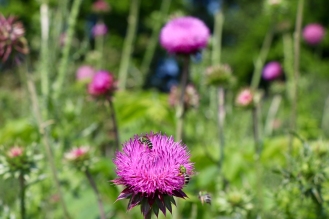Carduus nutans
As my previous post about thistles noted: “there are many species of thistles, including the locally common Bull thistle, Canada thistle, Plumeless thistle, Musk thistle, and Field thistle. Some are native and some are introduced. You can find thistles blooming throughout the summer and they are are never hard to find! Just ask any pollinator!”
This morning I noticed a tall stand of Nodding Thistle (also known as musk thistle) growing along the walking path at Heritage Park. All the giant, reddish-purple blooms were facing east, and many were “nodding” downward. This plant can reach 8 feet in height, so a thick stand of it can look like an intimidating forest!
The green parts of nodding thistle are spiny, waxy, tough, and practically impenetrable, but the flowers are gorgeous and insects clearly love them for their nectar. In addition to honey bees and bumble bees, the flowers were frequented this morning by Ultragreen Sweat Bees and a multitude of butterflies. Thistle flowers are large enough for birds to land on them too! Goldfinches love to eat thistle seeds.
Although this introduced species is considered a noxious invasive weed, it was hard to not admire it today in the morning sun! Even the unopened flowers were visually interesting.













As always, nice photos of wild plants and great descriptions. I knew Milk Thistle to be a great medicinal as wella food source. It seems that most thistles, like this one, share the same properties. I found this link for Carduus nutans that’s an easy read which tells more about those attributes: http://www.wildflowers-and-weeds.com/weedsinfo/Carduus_nutans.htm